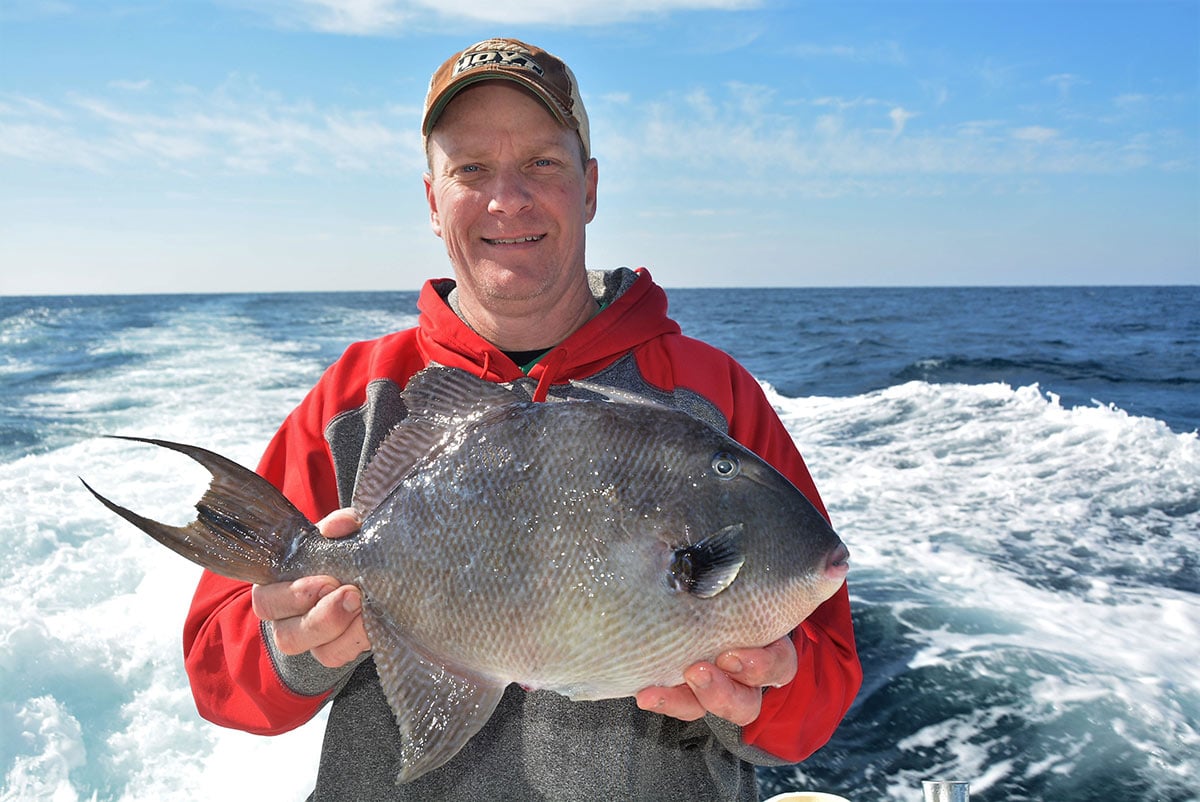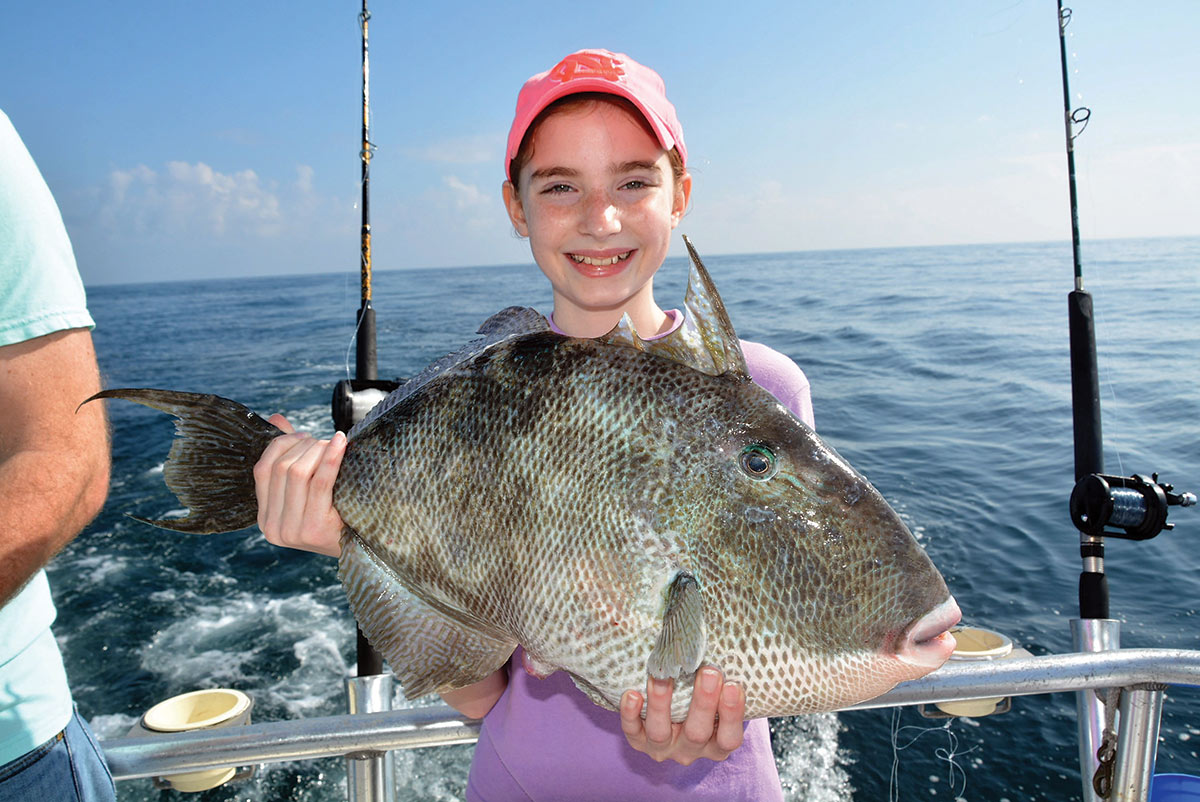
The gray triggerfish has become a targeted species for many anglers in the Northeast due to a dramatic increase in their numbers.
It was a sunny and mild October morning back in 1978 when my high school buddy Brian Johnston and I were rock hopping along the Sore Thumb jetty located along the north side of Fire Island Inlet on Long Island’s South Shore. Brian and I were hell bent on putting some early season blackfish on ice, and the action was steady as our fiddler and green crab baits kept us swinging away at cunners and rat blackfish with an occasional keeper to 3 pounds. Suddenly the tip of my rod went from the typical rapid fire hits to a solid whack that caught me by surprise. Once hooked, I was certain my crab bait had finally settled in front of a hefty tog. After a brief but spirited battle, my dream of my first big tog was put on hold as Brian slid the long handle net under a colorful and husky triggerfish. The surf veterans who frequented the jetty way back then estimated the fish at around 5 pounds. Uncertain whether triggerfish made good table fare, I safely released the southern visitor to fight another day.
Many triggerfish have come and gone over the gunnels of my boats since that day over 40 years ago. Since that time I’ve learned a thing or two about the species, but what is more relevant is how triggerfish have gone from a southern visitor to a southern invader as large numbers of triggerfish have been returning to our waters each summer. Scores of anglers are now targeting triggers on a regular basis while being entertained by their fighting ability and enjoying some great meals.
The Gray Triggerfish
Although there are more than forty species of triggerfish that are scattered throughout the world, the gray (grey) triggerfish is the prominent species that crams into most nook or cranny lairs along the Northeast during the summer and early fall seasons. Triggerfish get their name from spines on the dorsal fin that can be used as a defense against predators, and for anchoring themselves into protective structure. The first spine is large, and when erect, it remains so until the fish folds the smaller second spine, “triggering” the first. When a triggerfish is threatened, it will dive into a tight crevice and anchor itself into place by locking its erect spine. Sharks prey upon adult gray triggerfish, while tuna, bull dolphin, marlin, sailfish and sharks prey upon juvenile gray triggerfish.
As for identifying gray triggerfish, adults are primarily olive-gray, have blue spots and lines on the upper body and dorsal fin, and the upper rims of their eyes are blue. Along the tops and bottoms of their bodies they sprout large fins. The top fin (dorsal) and bottom fin (anal) are quite large, and provide most of the fish’s motion. When they must swim quickly, they use their tail fins. These beautiful fish are intriguing creatures, which have a number of traits and behaviors to help them survive in their ocean environment.
Triggerfish primarily eat benthic invertebrates including crabs, sea urchins, shrimp, sand dollars, lobsters and mollusks. They have a small mouth with a strong jaw and specialized teeth used to crush and chisel holes in their hard-shelled prey. These bottom dwellers dig out prey, such as crabs and worms, by flapping away debris with their fins and sandblasting with water squirted from their mouths. They also employ their very tough teeth and jaws to take on sea urchins, flipping them over to get at their bellies, which are armed with fewer spines. Triggerfish wreak such havoc on less fortunate reef dwellers that smaller fish often follow them to feast on their leftovers. Juvenile gray triggerfish feed on hydroids, barnacles and polychaetas.
Where to Find Them
Locating triggerfish is just as easy inside a sheltered bay as finding them out in the Big Pond. Inside the bays, look for bottom structure such as rocky ledges, rock piles, broken docks or anything with some sort of obstruction. Green can and red nun buoys and their buoy chains are great places to find triggerfish, especially those near ocean inlets during a flood tide when the water is at its cleanest. As for the ocean fish, you can start right at the local jetties during slack tide, then as you move offshore, artificial reefs, clam beds and hard bottoms offer the best opportunity for triggerfish. Boat positioning is critical and proper anchoring is the key. If you’re off the structure by 40 or 50 feet, you may not catch triggerfish, even though they may be plentiful just a few yards away.
Triggerfish are infamous for their nasty attitude and this behavior is especially evident around nests, other fish or divers are likely to be charged or bitten. However, they don’t attack without reason. Most angry triggerfish are actually protecting their nests from perceived predators. Once caught and out of the water, triggerfish would love nothing more than to rip the flesh right off your fingers. This species sees just as good out of water as in it, therefore handle these fish with caution.

Tackle
A standard slip sinker, or in-line sinker rig, attached to 20-pound main line with 1 to 2 ounces of lead, and a 30-pound fluorocarbon leader rounds out this rig. A more effective rig, particularly for quick jawed bait stealers is the Knocker Rig, which is popular along the southern states. This rig puts a slip sinker on the leader so it slides down and “knocks” against the hook for a streamlined presentation. When a triggerfish takes the bait, the leader slips back through the weight so the fish feels no resistance. Depending on water depth, knockers with 1- to 2-ounce weights sliding over 1/0 or 2/0 super sharp Gamakatsu octopus hooks will do the job. When a triggerfish gets a solid grip on a bait, just let the fish pull the rod tip down and continue the pressure with steady reeling. Don’t jerk the rod, just respond. Lastly, the most commonly employed rig in the Northeast is a hi/low rig, which is a pair of hooks on dropper loops with a sinker rigged at the tag end. The setup keeps the pair of baits about a foot or so off the bottom.
Speaking of rods and reels, when fishing on the reefs or any area of structure with sticky bottom for that matter, your best results will come from rods with fast taper tips for sensitivity, and powerful butt tapers for the lift needed to haul any outsize species from structure. I match the rods with a conventional reel with a 6 to1 ratio to get the fish off the structure before they have a chance to turn their head and head for safety.
Bait and Chum
It’s true triggerfish depend on benthic invertebrates to live happily in the sea. However as omnivorous feeders, pleasing their palate is as easy as whatever bait is available at the time. Therefore it doesn’t matter if Asian, fiddler or green crabs is the bait of choice or something as simple as a strip of squid or clam. All these baits will get the attention of a hungry triggerfish.
Whether fishing the buoy chains in the bay or fishing on one of the several artificial reefs or wrecks out in the ocean, employing chum will undoubtedly increase the action immensely. In fact, chumming correctly can help generate some wild action. We had many trips when reeling in a single or double header of triggerfish, 30 or 40 other triggers came to the surface and were more than willing to take whatever bait or chum we had to offer.
When fishing along the buoys and their chains, it is best to anchor approximately 100 feet up tide from the designated structure and hang a chum bag over the side and allow the chum to flow into the current and let it work its magic. Triggerfish are not shy and will often come to the surface for a free meal. The variety of rigs described will all work well along the chains. In the ocean where most fishing will be done in relatively deep-water, sending a chum pot filled with a log of clam or bunker chum down to the bottom will produce an aquarium of species and a high/low rig will keep the rods bent.
Dressing a Trigger
Triggerfish belong to a group of species collectively known as leatherjackets for their extremely tough skin and without a distinct plan, accessing the prized meat can seem like trying to crack a locked safe. The road to successfully filleting your day’s catch begins with a high quality fillet knife sharpened to perfection. Puncture the fish’s skin in the soft area just behind the gills, cut upward to the dorsal fin and then start working the blade down the backbone and around the rib cage. Repeat the process on the other side. Trying to find an entry point on the back, or trying to cut from the tail forward is a lesson in futility. The good part about the trigger’s tough skin is that removing the meat is like scraping butter off a slice of toast.
Keep in mind that there are no regulations for gray triggerfish in our region as of now, however, that can change quickly if National Marine Fisheries feel the fishery is threatened or overfished. Practice self-restraint by taking only what you need and release the rest for another day.
| RECIPE: CARIBBEAN TRIGGERFISH |
|---|
| This recipe calls for keeping the fish whole. First, cut from the anal vent forward and remove all the innards, along with the eyes and gills. Stuff the cleaned-out cavity with shrimp/scallop dressing or pieces of your favorite citrus. Score the flanks and drench with melted butter and citrus juice. Place the fish in a greased dish and bake at 350 degrees for 20-30 minutes. If you enjoy the flavor of the fishes of the Caribbean and South America, you’re going to love the mild, firm white meat of the triggerfish. |




